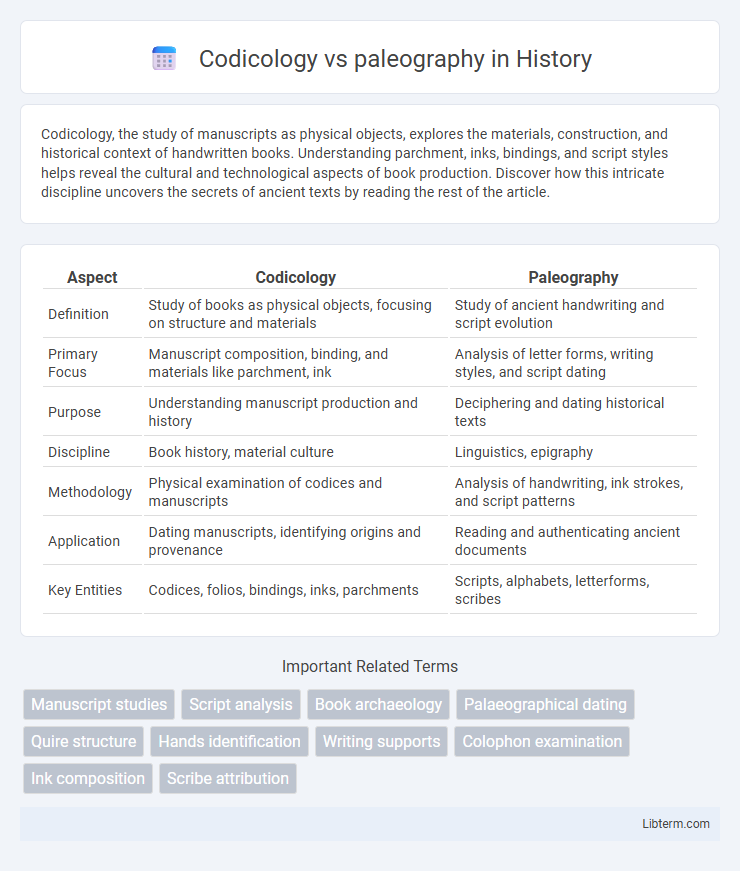Codicology, the study of manuscripts as physical objects, explores the materials, construction, and historical context of handwritten books. Understanding parchment, inks, bindings, and script styles helps reveal the cultural and technological aspects of book production. Discover how this intricate discipline uncovers the secrets of ancient texts by reading the rest of the article.
Table of Comparison
| Aspect | Codicology | Paleography |
|---|---|---|
| Definition | Study of books as physical objects, focusing on structure and materials | Study of ancient handwriting and script evolution |
| Primary Focus | Manuscript composition, binding, and materials like parchment, ink | Analysis of letter forms, writing styles, and script dating |
| Purpose | Understanding manuscript production and history | Deciphering and dating historical texts |
| Discipline | Book history, material culture | Linguistics, epigraphy |
| Methodology | Physical examination of codices and manuscripts | Analysis of handwriting, ink strokes, and script patterns |
| Application | Dating manuscripts, identifying origins and provenance | Reading and authenticating ancient documents |
| Key Entities | Codices, folios, bindings, inks, parchments | Scripts, alphabets, letterforms, scribes |
Understanding Codicology: The Study of Books as Objects
Codicology examines the physical structure and materials of manuscripts, such as parchment, binding, and ink, to understand the historical context and production techniques of books as tangible objects. Paleography focuses on analyzing handwriting styles and scripts to date and authenticate texts, providing insights into the evolution of writing systems and scribal practices. Studying codicology reveals the craftsmanship and cultural significance behind manuscript creation, complementing paleographic analysis for comprehensive historical research.
Paleography Defined: The Art and Science of Ancient Writing
Paleography is the study of ancient handwriting, focusing on the analysis and dating of historical scripts to decipher, interpret, and authenticate manuscripts. It involves examining letter forms, styles, and materials used in writing across different cultures and time periods, providing critical insights into historical contexts and linguistic evolution. Codicology, by contrast, centers on the physical aspects of manuscripts, such as their structure, binding, and materials, complementing paleography by offering a comprehensive understanding of ancient texts.
Historical Development of Codicology and Paleography
Codicology, the study of manuscripts as physical objects, developed in the 19th century with scholars like E. A. Lowe emphasizing the analysis of book construction, materials, and binding. Paleography, dating back to the Renaissance, evolved through the systematic study of ancient handwriting to decipher and date historical documents. Both disciplines emerged from the need to authenticate and contextualize medieval texts, but codicology focuses on the manuscript's materiality, while paleography concentrates on script and handwriting styles.
Key Differences Between Codicology and Paleography
Codicology studies the physical aspects of manuscripts, including their materials, structure, and production techniques, while paleography focuses on the analysis and interpretation of handwriting styles and scripts. Codicology examines features like parchment quality, ink composition, and bookbinding methods, which provide insights into the manuscript's origin and historical context, whereas paleography deciphers letter forms, abbreviation systems, and writing conventions to date and localize texts. Both disciplines complement each other by combining material evidence with script analysis to enhance the understanding of historical documents.
Overlapping Areas: Where Codicology Meets Paleography
Codicology and paleography intersect in the analysis of manuscripts by examining handwriting styles, script types, and material aspects like ink and parchment to date and localize texts accurately. Both disciplines contribute to understanding the historical context and production techniques of medieval and early modern books through detailed study of letter forms, scribal practices, and codex structures. This overlapping focus enhances the reconstruction of manuscript provenance and the evolution of writing systems in cultural and archival research.
Methodologies in Codicological Research
Codicological research employs material analysis techniques such as parchment examination, binding structure assessment, and ink composition studies to understand manuscript production and history. It integrates multispectral imaging and digital tools to decode physical features, facilitating the reconstruction of codex creation and usage patterns. These methodologies contrast with paleography's focus on handwriting style analysis and letterform evolution to date and localize manuscripts.
Techniques in Paleographic Analysis
Techniques in paleographic analysis involve examining the handwriting styles, letterforms, and script evolution to date and localize manuscripts, employing methods like ductus analysis and character morphology assessment. Codicology complements this by studying the physical aspects of the manuscript, such as binding, foliation, and materials, offering context for the paleographic findings. Together, these disciplines provide a comprehensive understanding of historical texts through both script analysis and codex construction.
Applications in Manuscript Studies
Codicology examines the physical structure of manuscripts, including materials, binding, and foliation, providing insights into the historical context and production techniques. Paleography focuses on the analysis of handwriting styles and script evolution to date and localize manuscripts, aiding in authorship identification and textual transmission studies. Both disciplines are essential in manuscript studies for authenticating documents, reconstructing provenance, and understanding the cultural significance of historical texts.
Challenges in Codicology and Paleography
Challenges in codicology include deciphering the physical composition and history of manuscripts, such as identifying materials, binding techniques, and provenance, often complicated by damage or restoration. Paleography faces difficulties in interpreting ancient handwriting styles and scripts, which vary widely across regions and time periods, requiring expertise to accurately transcribe and date texts. Both fields demand interdisciplinary knowledge and advanced technologies like multispectral imaging to overcome the limitations posed by deteriorated or obscure sources.
Future Perspectives in Codicology and Paleography
Future perspectives in codicology and paleography emphasize the integration of artificial intelligence and machine learning to enhance manuscript analysis and dating accuracy. Advances in multispectral imaging and 3D scanning technologies enable detailed examination of palimpsests and material composition, providing deeper insights into historical contexts. Collaborative digital databases and open-access platforms are expected to revolutionize cross-disciplinary research and global accessibility to manuscript collections.
Codicology Infographic

 libterm.com
libterm.com